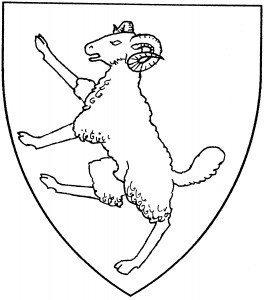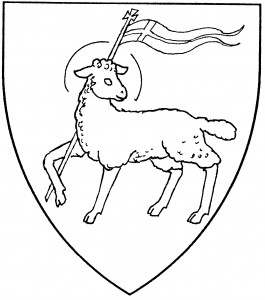The sheep is a wooly, grazing beast famed for its placidity, yea, stupidity. It’s found in the arms of Schafli, c.1340 [Zurich 389].
The category includes the “ram”, the male sheep, a symbol of virility, distinguished by his spiral horns, found in the canting arms of Ramsberg c.1370 [Gelre 40]; and the “lamb”, the young sheep, a symbol of meek innocence, found in the canting arms (Latin agnus) of Agnis, 1286 [DBA1 295]. Ovines are often found statant or rampant, but there doesn’t seem to be a default posture common to all; but in general, rams are more often rampant, and sheep more often statant. The illustration shows a ram rampant.
There is also the “Paschal lamb”, a reference to the Lamb of God: he bears a banner over his shoulder, and is passant by default. (He is often shown reguardant as well, as in the illustration, but that fact is always blazoned.) When blazoned “proper”, the Paschal lamb is argent, haloed Or (sometimes with a red cross on the halo), and his banner is argent with a red cross. It’s found as an heraldic charge as early as 1304, in the arms of Barbitonsor [DBA1 205].
The Society currently grants difference between sheep and goats. For related charges, see fleece, goat, musimon. See also vegetable lamb.
The King of Gleann Abhann bears: Per pale gules and sable, a ram rampant within a laurel wreath, in chief a coronet argent.
Ælfhelm se Reade bears: Vert, three sheep statant argent.
Robert MacNair bears: Erminois, three rams rampant sable.
Karl Skarpi bears: Gules, a Paschal lamb passant proper between three crosses crosslet Or.

